On a brisk Monday morning in late August 2025, President Donald Trump stood before reporters in the Oval Office and floated a proposal that would soon ignite a heated national debate: renaming the Department of Defense as the Department of War. According to The Wall Street Journal, this idea, first casually mentioned by Trump on August 25, quickly transformed into a formal policy push within the White House. The administration’s plans, as reported on August 30, have since stirred conversations across Congress, the Pentagon, and the American public about history, symbolism, and the future direction of the U.S. military.
Trump, never one to shy away from bold rhetoric, explained his reasoning with characteristic bluntness. “It used to be called the Department of War and it had a stronger sound,” he told the assembled press. “We want defense, but we want offense too ... As Department of War we won everything, we won everything and I think we’re going to have to go back to that.” The president’s words, quoted widely by Reuters and other outlets, set the stage for a policy debate that is as much about national identity as it is about military strategy.
The administration’s move is more than mere rebranding. Restoring the Department of War name for the government’s largest department would likely require congressional action—a significant hurdle, given the political divides in Washington. Yet, as The Wall Street Journal noted, the White House is also exploring alternative methods to implement the change, should Congress prove unwilling. Republican Representative Greg Steube of Florida has already filed an amendment to the annual defense policy bill proposing the name change, signaling at least some Republican support in Congress for Trump’s vision.
White House spokeswoman Anna Kelly, echoing the president’s focus, underscored the administration’s rationale. “As President Trump said, our military should be focused on offense – not just defense – which is why he has prioritized warfighters at the Pentagon instead of DEI and woke ideology. Stay tuned!” Kelly told reporters, referencing DEI (diversity, equity, and inclusion) programs that have become a flashpoint in recent political debates. Kelly’s comments, reported by Reuters, highlight the administration’s intent to shift priorities at the Pentagon away from social initiatives and toward what they describe as core military readiness and aggression.
To understand the significance of this proposed change, it’s worth revisiting the department’s history. The War Department, as it was originally known, dates back to the nation’s founding. However, the aftermath of World War II brought about sweeping reforms. The National Security Act of 1947 unified the Army, Navy, and the newly created Air Force under a single organization—the National Military Establishment. Just two years later, an amendment to the law officially renamed the agency the Department of Defense, establishing the structure and branding that have endured for more than seven decades. The shift was intended to reflect a new era in which the United States saw itself as a global stabilizer and protector, rather than merely a nation at arms.
Trump’s call to restore the old name is more than nostalgia; it’s a signal of a broader philosophical shift. Since returning to office, Trump and his Defense Secretary, Pete Hegseth, have made no secret of their desire to promote a more aggressive image of the U.S. military. According to The Wall Street Journal, this has included a spate of personnel changes, with top military leaders whose views were seen as at odds with Trump’s being purged from their posts. Critics argue that this approach undermines the military’s tradition of nonpartisan service and risks politicizing the armed forces, while supporters see it as a necessary corrective to what they describe as years of bureaucratic drift and ideological distraction.
The debate over the department’s name is also entangled with other controversial policies emanating from the Trump administration. Notably, the White House has sought to bar transgender individuals from joining the U.S. military and to remove those currently serving. The Pentagon has justified this move by labeling transgender people as medically unfit for service—a claim that civil rights activists say is both untrue and discriminatory. According to Reuters, activists argue that this policy constitutes illegal discrimination and undermines the principle of equal opportunity in the armed forces.
Supporters of Trump’s proposal argue that the Department of Defense’s current name reflects an overly cautious, even passive, approach to national security. They point to the nation’s past victories under the War Department banner and suggest that a return to the old name would signal renewed strength and resolve. “As Department of War we won everything,” Trump insisted, tapping into a sense of nostalgia for a more muscular era of American power.
Opponents, however, warn that the name change would send the wrong message to both allies and adversaries. They argue that the Department of Defense’s current name reflects the United States’ commitment to peace and stability, and that reverting to the Department of War could be interpreted as a shift toward militarism and aggression. Some military historians note that the original change in 1949 was meant to signal a more balanced, responsible approach to global affairs, particularly in the wake of the devastation wrought by World War II.
Behind the scenes, the legislative path to a name change is anything but straightforward. While Representative Steube’s amendment signals some Republican support, the proposal faces long odds in a divided Congress. Many lawmakers—on both sides of the aisle—are wary of making such a symbolic change at a time when the nation faces a host of other pressing challenges, from international tensions to domestic polarization. Still, the White House’s willingness to explore “alternative methods” suggests that the administration is determined to push the issue, one way or another.
The broader context of this debate cannot be ignored. In recent years, the U.S. military has found itself at the center of political and cultural battles—from questions about diversity and inclusion to debates over the proper role of the armed forces in a democratic society. Trump’s push to rebrand the Pentagon is the latest flashpoint in a long-running struggle over the identity and mission of America’s military establishment.
As the proposal works its way through the corridors of power, one thing is clear: the question of what to call the nation’s military apparatus is about more than words. It’s a reflection of deeper currents—about how America sees itself, how it wishes to be seen by the world, and what values it chooses to elevate in moments of change. Whether Congress embraces Trump’s vision or not, the debate itself is a telling sign of the times.




